Titian, born Tiziano Vecellio, is universally recognized as one of the greatest painters of the Italian Renaissance. Hailing from the Venetian school,
Titian’s work is renowned for its vibrant color, innovative compositions, and expressive brushwork. His artistic journey spanned over six decades, during which he profoundly influenced the art world and shaped the course of Western painting. Read on as we delves into Titian’s life and legacy, exploring why he is celebrated as a master of the Renaissance and highlighting ten of his most important works.
Table of Contents
- The Life and Legacy of Titian
- The Significance of Titian’s Work
- Ten Important Works by Titian and Their Significance
- Assumption of the Virgin (1516-1518)
- Bacchus and Ariadne (1520-1523)
- The Venus of Urbino (1538)
- Portrait of Charles V with a Dog (1533)
- Rape of Europa (1560-1562)
- Diana and Actaeon (1556-1559)
- Sacred and Profane Love (1514)
- The Flaying of Marsyas (1570-1576)
- Pesaro Madonna (1519-1526)
- Self-Portrait (1562)
- Listen To Our Podcast About Why Is Titian Known as the Master of the Venetian Renaissance? Below or By clicking here.
- Related Questions
The Life and Legacy of Titian
Like many Renaissance painters, Titian led a fascinating life. However, beyond his personal story, his art left a profound legacy.

Early Life and Training
Titian was born around 1488-1490 in Pieve di Cadore, a small town near the Alps. As a child, he moved to Venice, where he began his artistic training under the guidance of Gentile Bellini and later his brother Giovanni Bellini, the leading artist in Venice at the time.
Titian’s early work reflects the influence of the Bellini brothers and Giorgione, another prominent Venetian painter. The young artist quickly absorbed the prevailing styles and techniques but soon developed his distinctive approach to color and form.
Artistic Evolution and Style
Titian’s work is characterized by its bold use of color, dramatic compositions, and lifelike representations. He was a master of chiaroscuro, using strong contrasts between light and dark to create a sense of volume and depth.
His use of color was revolutionary; he layered glazes to achieve luminous, rich hues that brought his subjects to life. Titian’s brushwork evolved over his career, becoming looser and more expressive, which allowed him to convey emotion and movement with remarkable subtlety.
Recognition and Patronage
Throughout his career, Titian enjoyed the patronage of some of the most influential figures of his time, including the Holy Roman Emperor Charles V and King Philip II of Spain. His status as a favored artist of the Venetian Republic also ensured a steady stream of commissions.
These relationships secured his financial success and allowed him to work on a wide range of subjects, from religious and mythological themes to portraits and landscapes.
The Significance of Titian’s Work
Titian’s influence extends beyond the borders of Italy. He set new standards for portraiture and narrative painting that resonated across Europe. He was a pioneer in many respects, blending the humanistic ideals of the Renaissance with his unique artistic vision.
His exploration of color, texture, and emotion has inspired generations of artists and made him a cornerstone in art history.
7 Important Facts About Titan
Even today, Titian remains a highly significant painter. Here are some facts about him that highlight his enduring relevance:
Pioneer of Color Techniques:
Titian revolutionized the use of color in painting, developing techniques that influenced countless artists after him. His ability to create vibrant, luminous colors set a new standard for painters of his time and beyond.
Versatility in Subjects:
Titian was adept at various subjects, from religious and mythological scenes to portraits and landscapes. His versatility allowed him to explore and innovate across different genres.
Influence on Future Artists:
Artists such as Peter Paul Rubens, Rembrandt, and even more modern painters like Picasso admired and were influenced by Titian’s work. His exploration of expressive brushwork and dynamic compositions paved the way for future artistic developments.
Innovative Portraiture:
Titian’s approach to portraiture, which captured the personality and status of his subjects with unprecedented realism and psychological depth, has had a lasting impact on how portraits are conceived and executed.
Cultural Impact:
His paintings not only reflect the ideals and aesthetics of the Renaissance but also capture his time’s social and political dynamics. This makes his work a valuable resource for understanding the cultural history of the period.
Continued Study and Exhibition:
Titian’s works are regularly featured in exhibitions and historical research, underscoring his lasting significance in art history. His paintings are held in major museums worldwide, continuing to draw admiration and scholarly attention.
Technical Mastery:
His techniques, particularly his use of glazes and innovative brushwork, continue to be studied and admired by artists and art historians, showcasing his mastery and technical skill.
These aspects of Titian’s legacy demonstrate why he remains an important figure in art history. His influence is still felt in contemporary artistic practices and scholarship.
Ten Important Works by Titian and Their Significance
As a significant artist, Titian created numerous essential works of art. Here are ten of our favorite and most significant pieces by him:
Assumption of the Virgin (1516-1518)

- Location: Santa Maria Gloriosa dei Frari, Venice
- Significance: This monumental altarpiece is one of Titian’s early masterpieces, showcasing his mastery of composition and color. The work captures the dramatic moment of the Virgin Mary’s assumption into heaven, with a powerful use of perspective that draws the viewer’s eye upward. The vibrant colors and dynamic arrangement of figures demonstrate Titian’s break from the static compositions of earlier Venetian art, setting a new standard for religious painting.
Bacchus and Ariadne (1520-1523)
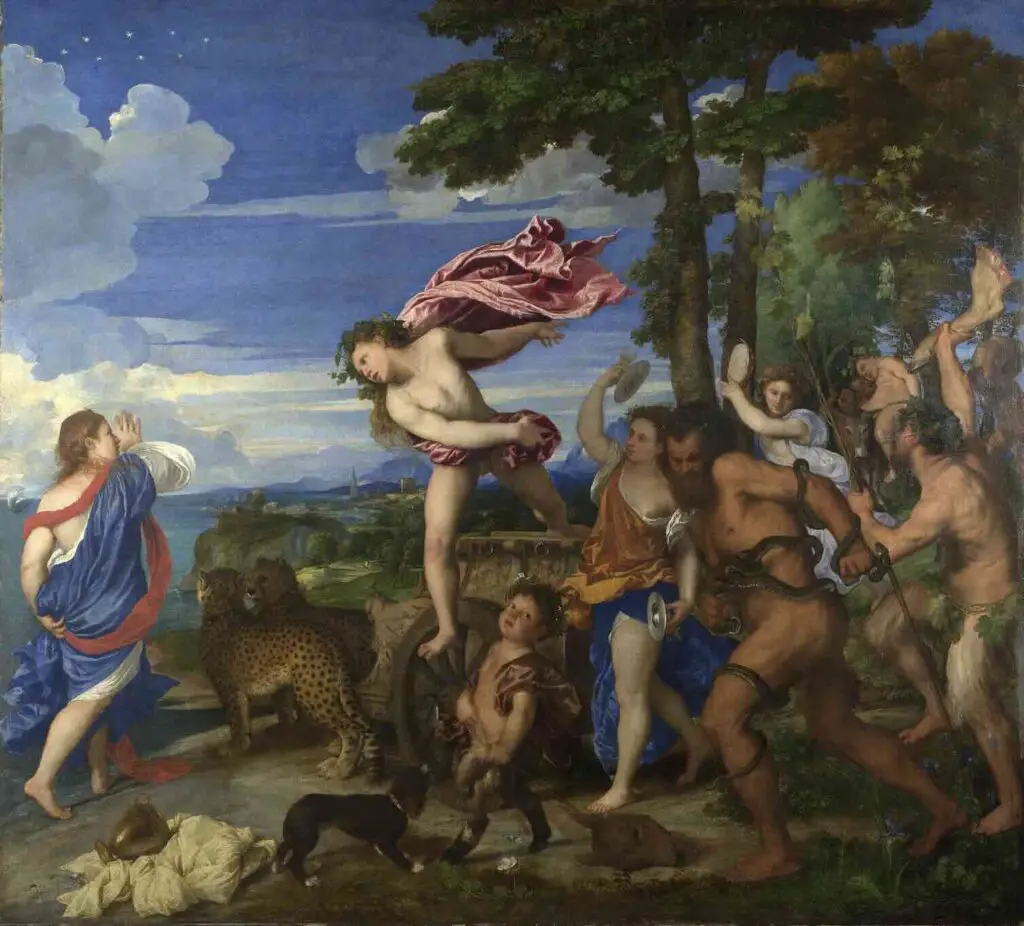
- Location: National Gallery, London
- Significance: Commissioned by the Duke of Ferrara, this painting depicts the mythological story of Bacchus discovering the abandoned Ariadne. Titian’s use of bright, contrasting colors and the fluidity of the figures convey a sense of movement and joy. The work is notable for its vibrant palette and the depiction of Bacchus mid-leap, a testament to Titian’s skill in capturing motion.
The Venus of Urbino (1538)
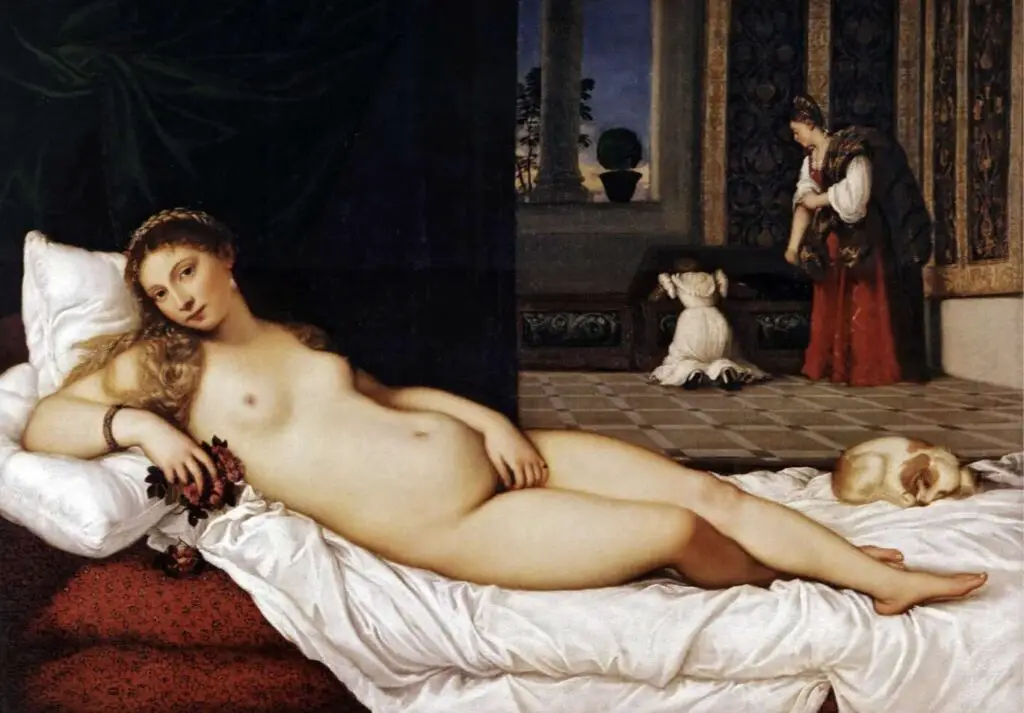
- Location: Uffizi Gallery, Florence
- Significance: One of Titian’s most famous works, this painting depicts a nude young woman reclining on a couch. The Venus of Urbino is celebrated for its sensuality and the softness of its forms. Titian’s use of warm colors and the luxurious setting emphasize the beauty and eroticism of the subject. The painting also showcases Titian’s ability to imbue his figures with a lifelike presence, making it a landmark in the history of portraiture.
Portrait of Charles V with a Dog (1533)
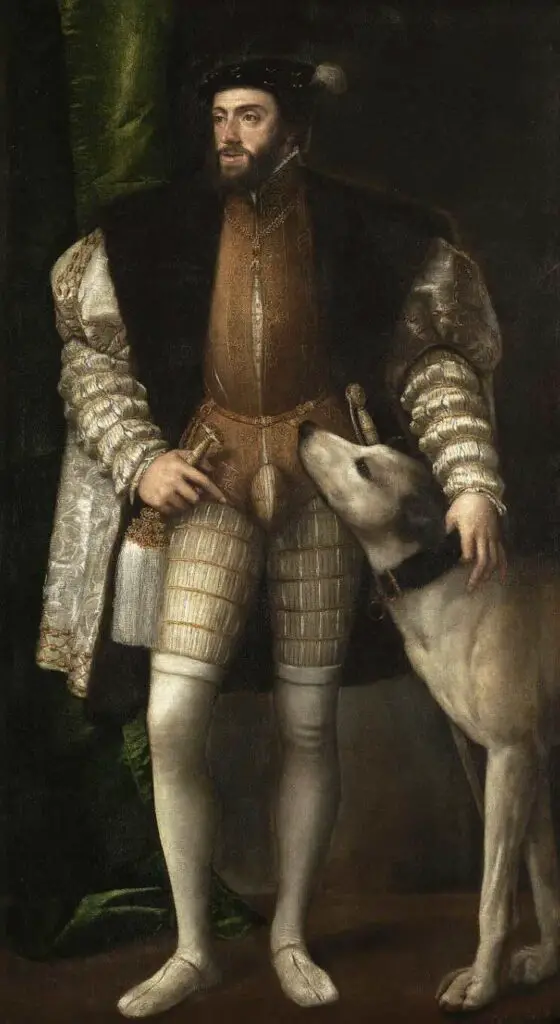
- Location: Museo del Prado, Madrid
- Significance: This portrait exemplifies Titian’s skill in capturing the personality and status of his subjects. Charles V is depicted in a relaxed pose, with a dog at his side, symbolizing loyalty. The detailed rendering of the emperor’s face and clothing reflects Titian’s mastery of portraiture, making this work a vital historical document of one of the most powerful rulers of the Renaissance.
Rape of Europa (1560-1562)

- Location: Isabella Stewart Gardner Museum, Boston
- Significance: This mythological painting depicts the abduction of Europa by Zeus, who has transformed into a bull. The work is known for its dramatic composition and the intense expressions of the characters. Titian’s use of color and light heightens the scene’s emotional impact, making it one of his most potent mythological paintings. The painting also demonstrates his mature style, characterized by loose brushwork and rich color.
Diana and Actaeon (1556-1559)
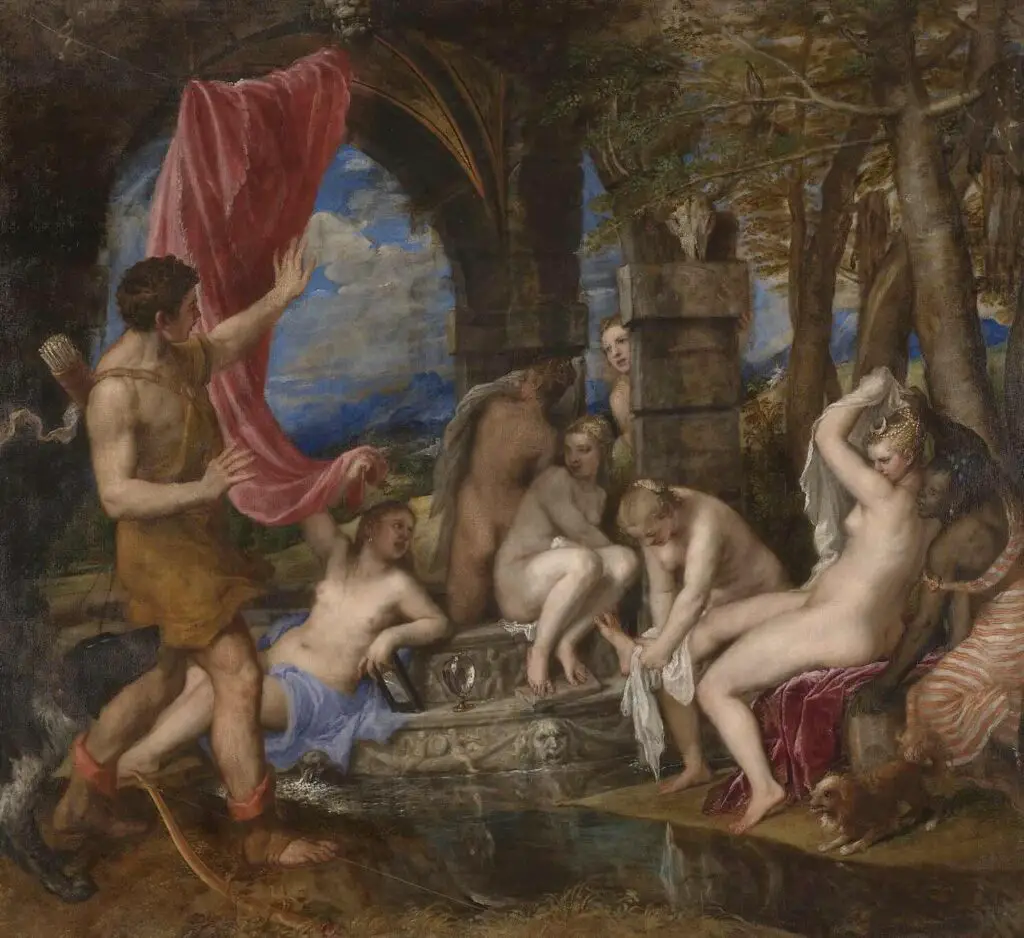
- Location: National Gallery, London
- Significance: Part of a series of mythological paintings commissioned by King Philip II of Spain, this work portrays when the hunter Actaeon stumbles upon the goddess Diana bathing. The composition is dynamic, with Titian skillfully arranging the figures to convey the surprise and tension of the scene. The painting is noted for its lush depiction of nature and the delicate rendering of Diana and her nymphs.
Sacred and Profane Love (1514)
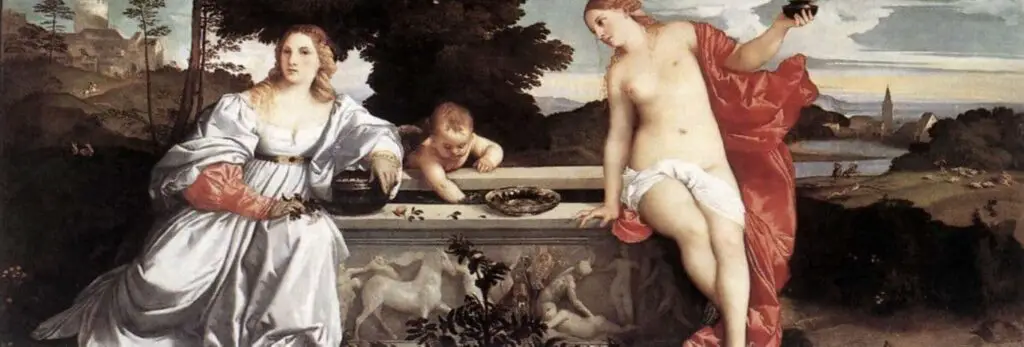
- Location: Galleria Borghese, Rome
- Significance: This enigmatic painting features two women, one dressed and one nude, seated by a well. The contrast between the two figures has led to various interpretations, often seen as an allegory of the dual nature of love—earthly and divine. The rich color palette and the exquisite details in the figures’ clothing and the landscape showcase Titian’s technical prowess and thematic depth.
The Flaying of Marsyas (1570-1576)

- Location: Kroměříž Archbishop’s Palace, Czech Republic
- Significance: One of Titian’s late works, this painting depicts the brutal mythological punishment of the satyr Marsyas. The work is striking for its raw emotion and the dramatic use of light and shadow. The expressive brushwork and the intense subject matter reflect Titian’s exploration of human suffering and mortality, themes that became more prominent in his later years.
Pesaro Madonna (1519-1526)
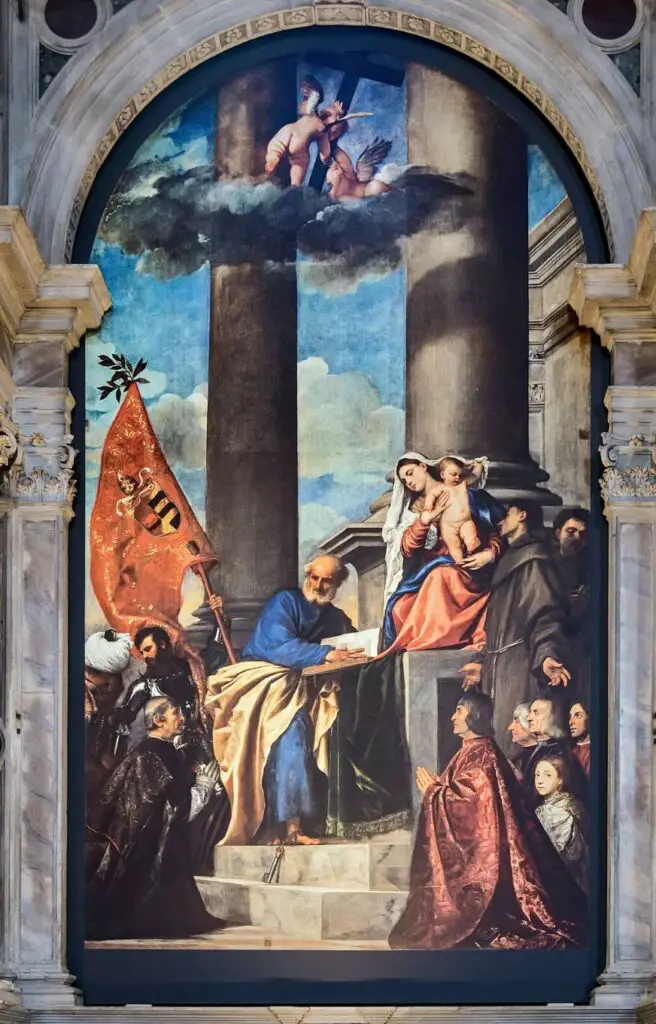
- Location: Santa Maria Gloriosa dei Frari, Venice
- Significance: This altarpiece significantly develops Titian’s use of space and composition. The painting features the Madonna and Child, along with members of the Pesaro family and saints, arranged in a dynamic diagonal composition. The use of architectural elements and vibrant colors make this work a key example of Titian’s mature style and innovative approach to religious art.
Self-Portrait (1562)

- Location: Museo del Prado, Madrid
- Significance: Titian’s self-portraits are rare, and this one provides a glimpse into the artist’s persona. The painting depicts Titian as a dignified, reflective figure, focusing on the expressive rendering of his face. The use of shadow and the simplicity of the composition highlight the artist’s mastery in portraying psychological depth. This self-portrait is a testament to Titian’s status as a revered artist and his reflective nature in his later years.
Titian’s legacy is not only defined by his technical innovations and mastery of color but also by his ability to capture the human experience in all its complexity. His works are celebrated for their beauty, emotional depth, and artistic brilliance. As one of the leading figures of the Venetian school,
Titian’s influence can be seen in the works of countless artists who followed, from the Baroque period to modern times. His contributions to art have ensured his place as a towering figure in the history of Western painting, making him truly deserving of the title “The Greatest Italian Renaissance Painter of the Venetian School.
Listen To Our Podcast About
Why Is Titian Known as the Master of the Venetian Renaissance? Below or By clicking here.
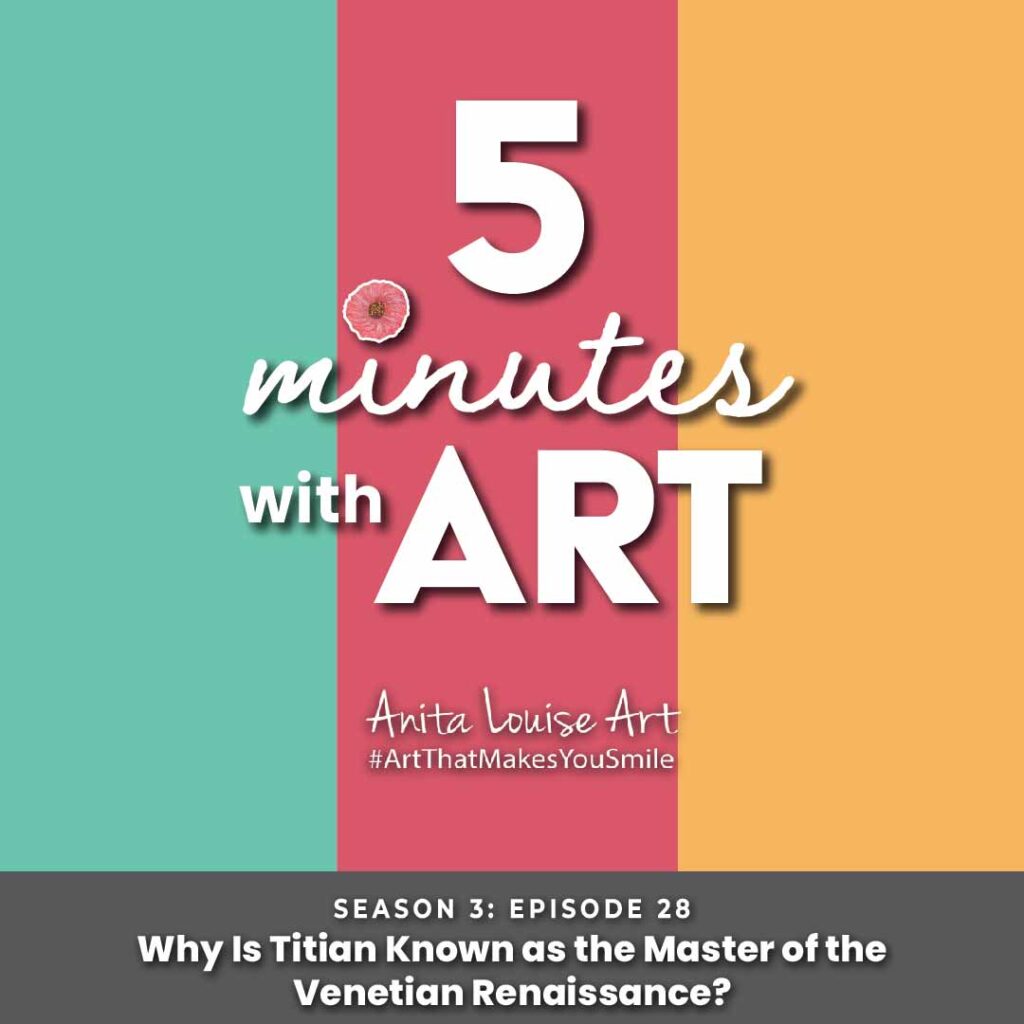
Anita Louise Art is dedicated to art education, great artists, and inspiring others to find and create their art. We love art that uplifts and inspires. #ArtToMakeYouSmile! #ArtToMakeYouHappy!
If you are interested to see any of my art, you can find out more by clicking here. If you are interested in what inspires me and my paintings, you can discover more by clicking here.
We have a free newsletter and would love you to be part of our community; you can subscribe to the newsletter by clicking here. If you have any questions, I would be happy to talk to you anytime. You can reach me, Anita, by clicking here.
Subscribe to our Anita Louise Art YouTube Channel filled with great videos and information by clicking here.
Related Questions
Is Art An Natural Gift, Or Can Anyone Be Good At Art If They Practice?
Most artists have some natural gift or desire to be an artist. But it is through their education, hard work, practice, and association with other artists that make all the difference. Having a natural gift is the start to becoming an artist, but just having a natural gift will not make you a good artist. Becoming a great artist requires practice, education, and a lot of hard work.
By clicking here, you can learn more by reading Is Art An Natural Gift, Or Can Anyone Be Good At Art If They Practice?
Artemisia Gentileschi And Breaking Gender Barriers In Art
In the 17th Century in Italy, women had two career choices: joining a convent and becoming a nun or wife and mother. The laws also dictated that the man in the women’s lives, such as their fathers, husbands, and even sons, would make all the decisions for their lives. Women during this time had very few rights.
By clicking here, you can learn more by reading Artemisia Gentileschi And Breaking Gender Barriers In Art.
What Is The Difference Between Unity And Harmony in Arts?
Harmony is about art that creates cohesiveness; it stresses the similarities but related parts in the work of art. Unity is a much broader term; unity is all about the different parts of the work of art that are separate but all work together as one. In other words, unity is all the parts working well together in art.
By clicking here, you can learn more by reading What Is The Difference Between Unity And Harmony in Arts?

